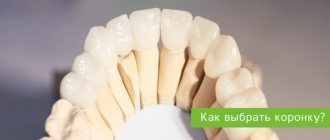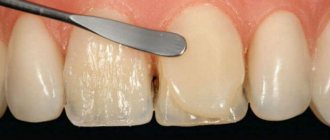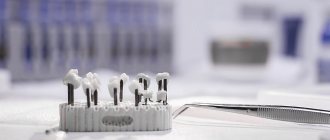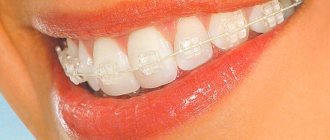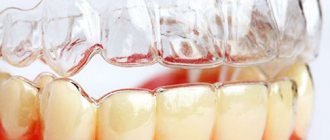Braces are an orthodontic structure that is placed on teeth to correct an overbite or irregularities in the dentition. The most common are metal and ceramic braces. Which ones should you choose and why? Let's find out what is better - metal or ceramics, and whether there are alternative options.
In this article
- Classification of braces
- What is the difference between metal braces and other types?
- Ceramic braces - what is the difference from metal braces?
- Which braces are better - metal or ceramic?
- Sapphire and plastic braces
- Combined systems
Braces are a permanent orthodontic structure that is attached to the teeth on the outside and/or inside of the jaw to correct misalignment or misalignment of the dentition. Outwardly, it resembles an arch with many small clasps on each tooth.
The braces are fixed in the grooves of the structure and glued to the enamel. They are installed for a period of one to three years, depending on medical indications and the type of orthodontic system. Which braces should you choose and why? Let's look at their main types.
What kind of design is this?
This is a modern device that straightens teeth and allows a person to feel confident due to the fact that they are practically invisible against the background of the enamel.
These systems are matte and their color can be matched to the shade of a person's enamel. Modern orthodontics is developing newer and more elegant designs that reduce metal and minimize external aesthetic inconveniences.
In terms of efficiency, they are not inferior to, and even superior to, conventional braces systems.
Conclusion
Choosing the right brace system depends on many parameters. In modern orthodontics, there are many different designs, each of which has advantages, disadvantages and may be the best option for a particular situation. When choosing braces for malocclusion treatment, you must, in addition to your own requirements, consult with an experienced orthodontist. You can undergo a comprehensive examination and consultation with a doctor, and then get high-quality, effective braces in our dentistry.
Posted by:
How are they arranged?
Such systems are designed to correct the position of teeth as quickly as possible, without pain and inconvenience , and with minimal aesthetic problems.
Ceramic braces are permanent structures. They consist of the following elements:
- clasps – their number is designed to be attached to each tooth, they are attached with special dental glue;
- arches are connections between clasps that are tightened for alignment with special devices; most often they are made of a material with memory in order to put an unevenly grown tooth in place.
The clasps are made of ceramic, and the arches are made of metal. Orthodontists can offer a system with a white arch , then such braces are practically invisible on the teeth.
What is the difference between metal braces and other types?
The first orthodontic braces, which were made of iron, appeared in 1955. Since then, they have remained virtually unchanged in their operating principle, but have become more convenient, smaller and safer. Such structures are made of steel, titanium or nickel. The main advantage of metal braces is their secure fit. They allow you to solve an orthodontic problem in a relatively short period of time.
There are other advantages to metal braces. Among them:
- high strength, the likelihood of damage to the structure is minimal;
- resistance to all types of dyes, metal is not stained by coffee, tea, soda and nicotine, and does not corrode;
- high hygienic characteristics, metal structures are less susceptible to bacteria;
- financial affordability: metal braces are much cheaper than ceramic braces.
Before choosing metal staples, check out their disadvantages:
- unaesthetic: metal braces look unsightly and can cause psychological discomfort in the patient, especially in a child;
- Not suitable for individuals intolerant to various metals.
However, the first point is relative. The negative attitude towards them is partly formed by cinema. Previously, in cinema, iron braces were installed on actors who had to play shy and insecure people, which is why the majority have a stereotypical opinion on this issue. Today, neat metal braces are made that do not spoil a person’s appearance and even become his highlight.
Kinds
Such constructions are divided into two types: ligature and non-ligature. Their installation is carried out according to the doctor’s indications and the patient’s wishes. They, like other leveling structures, have their advantages and disadvantages.
Ligature
Ligature ceramic braces do not contain metal elements other than the arch itself . Locks made of ceramic have a groove where the arch is attached.
There is also an elastic ring in the groove; it holds the arc. The ring is transparent and does not stand out against the background of the enamel . It was this element (ligature) that became the reason for the name of the design.
The advantages of ceramic ligature braces systems include:
- Colored ligatures are used, which is exciting and interesting for children and teenagers.
- Ligatures are elastic, which minimizes discomfort during the teeth straightening process.
- Effective.
Main disadvantages:
- Elastic elements may lose their elastic properties over time, in which case they will have to be replaced.
- Compared to non-ligated braces, they take longer to straighten teeth.
- The metal arc is fixed motionless, this increases friction and causes discomfort during use.
- Nicotine, coffee, strong teas and other food dyes can stain ceramics, which then releases ligatures onto the enamel.
- It is difficult to care for this structure.
- Ceramic ligature systems are more expensive and require monthly visits to the doctor.
Unligated
These structures can be adjusted themselves; they are also called self-ligating. They allow you to reduce the time required for the leveling process to a minimum.
Their peculiarity is that the system contains sliding clamps, which facilitates quick replacement of the arc. With such a replacement, the patient does not feel pain or any discomfort .
Here the arc is not blocked, but is fixed. It is comfortable and painless for the patient.
Such brace systems have their advantages:
- Injuries to the mucous membranes of the oral cavity occur very rarely; such ceramic structures operate with minimal pressure.
- Visiting a doctor is limited to once every 2-3 months.
- The friction force in this treatment is reduced, and the teeth straightening process occurs faster.
- Ceramics do not react chemically with saliva, so they are safe for health.
- When installing this design, oral care is simplified.
- Adaptation to the system occurs quickly due to the lack of bulkiness.
- Each tooth moves individually, falling into place.
- There are no contraindications for this treatment; even periodontitis is not an obstacle to straightening teeth.
- Installation and removal of ceramic non-ligature braces is quick and painless.
This system has no disadvantages; it is the latest development in orthodontics. The ceramic brace system is lightweight, which makes it much easier to get used to.
The difference between braces and choosing the best braces system: results
The conditions that determine the difference between different types of braces in terms of their attractiveness are numerous.
- Aesthetics. In descending order of aesthetic effect, a number of options can be arranged as follows: lingual, ceramic or sapphire external and metal structures.
- Easy to care for. It is easier to care for self-ligating systems than ligature ones; and vestibular than lingual. Although everything here is very individual.
- Reliability. The most durable materials are metal and ceramics. Which braces are better, ceramic or metal, must be decided based on price and specific indications.
- Price. Budget options - metal, plastic. But “Zuub” is an exception to the rule: promotions and discounts on premium solutions with ceramic and self-ligating structures are not uncommon.
- Ease of use. Non-ligature systems are easier and people get used to them faster. Lingual braces can affect diction - they will be distracting at first, but they are not visible to others.
The correct choice depends entirely on the significance of each factor given. Without an examination, we cannot state which option is right for you, but we know exactly where it is best to get braces in Moscow.
The Zuub Clinic works with all popular types of structures and offers competent assistance in choosing them. Our specialists will help you make the right decision on the price-quality ratio. Contact us, the first step - expert consultation - will be completely free for you and does not oblige you to anything.
If you have the symptoms described in this article, be sure to make an appointment at our clinic.
Don't self-medicate! Even the smallest problem, if not treated correctly, can significantly complicate your life.
By contacting us, you can be sure that:
- Get high-quality and free consultation .
- You will receive the best prices for treatment and the opportunity to receive a special promotional price.
- Only modern equipment and materials will be used.
- You will be treated by professional doctors with many years of experience.
- We offer treatment on credit or in installments. There is also the possibility of obtaining a tax deduction.
- We work seven days a week and without a lunch break, from 9 a.m. to 10 p.m.
+7 (495) 132-02-96
Make an appointment
Popular manufacturers
There are several companies specializing in the manufacture of ceramic braces systems. The main components of the designs are the same, but they also have their differences.
Clarity
The company produces aesthetic non-ligation braces systems; they are transparent, so they are practically invisible on the teeth . The design’s clasps are anatomical, which allows them to fit as closely as possible to the surface of the tooth.
They have a microcrystalline surface at the base and an anatomical contour of the base. Each brace is individually packaged and marked.
Damon
These designs differ in the structure of the braces. The company produces non-ligature systems; wire or rubber ligatures are not needed for their fastening.
photo: Damon Clear combined braces
The arc is attached to the locks themselves, this allows you to keep its mobility under control. The metal arch in braces is closed with the help of special caps that hold it. This design allows the use of softer arcs.
Reflections
Systems from this company are predominantly ligature. Reflections ceramic systems are composed of polycrystalline aluminum oxide. This material is durable and almost transparent. This allows us to characterize the systems from this company as aesthetic.
Usually ligatures stain over time, but Reflections braces do not. Ceramics are resistant to food dyes, as well as chemical and temperature influences. Such systems do not cause allergic reactions.
In-ovation
The newest non-ligature systems are lingual (which are installed on the back of the teeth) and vestibular. These are aesthetic systems; they do not injure the mucous membrane.
In such designs, rubber bands and wires are not used; there is a special mechanism for controlling the arc. Systems from this company allow you to track and control the movement of each tooth.
Ceramic braces - what is the difference from metal braces?
Ceramic braces are modern designs that have high aesthetic values. They do not differ in color from enamel, and therefore are practically invisible on the teeth. In addition, they are hygienic, lightweight, safe and have miniature locks that are easy to maintain. Also, ceramic braces do not cause allergies.
But they also have disadvantages. They are inferior to metal ones in efficiency. Defects that can be corrected with metal braces in one year are corrected with ceramic systems within 2-3 years. At the same time, ceramic products are much more expensive than iron ones. They are also not as durable and can break under strong mechanical stress. Thus, both types of systems have their pros and cons, which should be taken into account when selecting materials.
Flaws
Ceramic braces systems have their advantages and disadvantages. Their main disadvantages include:
- High cost - not every person can afford to install such systems. They are made of high-strength quality material, which increases their cost. Also, the price depends on the type of structure.
- The treatment period is slightly longer compared to metal braces. This occurs due to the fact that ceramics puts less pressure on the teeth, which slightly prolongs the period of their alignment.
- If ceramic braces fit too tightly to the enamel, this can lead to changes in its color, composition and destruction. The doctor regulates the tightness of such systems.
Price of dental braces
The price of dental braces is determined individually, calculated for each jaw and most of all depends on two conditions - material, installation method. If the cost of treatment is critical for you, then give preference to budget metal systems. They are noticeable, but effective, look neat, and are easy to install.
A compromise aesthetic option is ceramics. Zuub constantly runs promotions where you can install systems for literally 20–50% of the average market cost of such structures.
Lingual (invisible) products belong to the “premium” class, but provide exceptional aesthetics of the result. Their cost today varies between 50+ thousand per jaw. The most expensive systems are self-ligating, non-ligating.
Installation Features
Ceramic braces are installed on the outside of the teeth using special dental glue. This glue is selected for ceramics so as not to change its shade on the teeth. Locks are glued to each tooth separately.
Depending on the type of system, the arc is fixed. The installation process is not painful and takes from 20 to 40 minutes. But before installation, the patient must go through a preparatory stage with the making of impressions and filling of diseased teeth.
Classification by location: vestibular and lingual braces
Another important criterion when choosing a brace system for bite correction is the location of the locks. There are two types of systems, each of which is actively used in orthodontics:
- 1. Vestibular braces (standard, visible). Classic designs that are attached to the front surface of the teeth. These braces allow you to correct any type of malocclusion, regardless of severity and complexity. However, even the most aesthetic clasps made of ceramic or sapphire will still be noticeable on the teeth.
- 2. Lingual braces (they are also called “invisible braces”, or internal). They are installed on the inner surface of the dentition, so they are completely invisible. Minus - they have a number of restrictions for use. In particular, they are not suitable for defects that are too complex .
If you are thinking about which braces are best for a girl, a shy child or an adult, then lingual systems are best suited. However, the decision must be made together with the orthodontist.
Prescriptions and contraindications
Treatment with braces is prescribed from the age of 12 years, when all the teeth have changed and are ready for growth correction.
People who have anomalies in the growth of individual teeth and dentition , who want to improve the aesthetics of their face and profile, and who have unerupted teeth, need to wear braces.
Systems are also installed in preparation for prosthetics and corpus movement of teeth.
Contraindications to treatment with ceramic braces systems are:
- Enamel damage.
- Caries.
- A large number of fillings, crowns.
- Lack of proper nutrition skills (excessive consumption of sweets).
- Mental, immune, severe general somatic diseases.
- Allergy to materials of the brace system.
Adaptation
Getting used to braces varies from person to person.
For some, this process is painful and takes a lot of time, while others note that adaptation was quick and unnoticed.
But on average, the process of getting used to ceramic systems is accompanied by pain of varying intensity in the gums and teeth.
Sometimes the pronunciation of words and the process of chewing food suffer. If a person is determined to achieve a beautiful smile as a result of treatment, getting used to it will take a little time and effort.
Is there a compromise?
For clients who can’t decide whether to choose ceramic or metal braces, dentists today can offer a compromise option. Its essence is to install ceramic devices on the teeth located in the smile zone, and metal ones on all others.
This combination allows you to make the cost of orthodontic treatment more affordable, preserve the aesthetics of your smile and obtain excellent therapeutic results.
Remember: braces are just a tool in the hands of a doctor. An experienced doctor knows how to eliminate a patient’s defect using different types of devices. But he offers exactly those that will make your smile more attractive more quickly and less traumaticly. Therefore, trust your doctor and strictly follow all his instructions. By following this rule, you will correct your bite very quickly.
Care
The brace system makes oral care difficult. Therefore, you need to remember the care rules when installing ceramic structures to straighten your teeth.
- The toothbrush should have bristles with different directions. This will help clean hard-to-reach areas and the surface of the braces. The hardness of the brush should be medium.
- It is important to purchase small brushes. They are needed to clean the enamel under the arches and at the place where the clasps are attached.
- Dental floss can help clean out food debris well.
- You can use mouth rinses after meals to avoid premature darkening or plaque clogging of ceramic braces.
- Regular consultations with a dentist will help not only to properly align your teeth, but also to professionally clean the enamel surface.
How to care for braces?
Ceramic braces, like any other, must be properly cleaned and hygiene rules observed, since the teeth will be at high risk of caries for a long time. When wearing braces, you should avoid foods that stick to your teeth or can damage the braces. It is not recommended to eat chips, crackers, dried bread, caramel, toffee, chewing gum, or carrots. Temperature changes when eating hot and cold food are also not desirable.
When wearing braces, brushing your teeth should be done after every meal. For this, a special set is used, which includes a V-shaped brush and a brush for cleaning the space between the teeth and the arch. The process of cleaning braces is greatly facilitated by dental floss and dental rinse.
During cleaning, the brush is held vertically to clean the area under the arc. It is advisable to clean regularly, carry a irrigator, dental floss, and mouthwash with you. It is recommended to carry out hygienic cleaning twice a year to remove plaque.
Comparison of different systems
To understand which braces are better and how they differ, let's look at the following table.
| Types of braces systems: | Ceramic | Sapphire | Metal |
| Anomaly complexity | The aesthetic system copes with minor anomalies. | The aesthetic system copes with minor anomalies. | Coping with any anomalies. |
| Duration of treatment | Longer in terms of teeth straightening, 2-3 months longer to wear than metal ones. | The treatment period is not inferior to metal ones. | Fast in treatment due to a firmly controlled arc. |
| Aesthetics | Ceramics are matched to the color of the enamel. | Transparent, white-coated arcs, almost invisible when smiling and talking. | Not aesthetically pleasing, clearly visible on the teeth. |
| Price | Average in cost. | The most expensive. | Available for all patients. |
Which braces are better?
The final decision about which braces are best for you or your child is always the result of an analysis of a set of factors and conditions. The choice depends on the condition of the tooth enamel, the degree of curvature of the teeth, the patient’s age, budget, and individual contraindications (for example, an allergy to metal).
What braces are best for adults?
Age is one of the key factors in selecting an effective treatment program. What braces are best for adults? As our experience shows, there can be several correct solutions:
- metal structures are optimal if the key condition is the cost of treatment;
- ceramics are optimal for business people who do not want to draw attention to a temporary structure; or allergy sufferers;
- People with high sensitivity of teeth, gums and mucous membranes should vote for an external self-ligating system - such braces are easier to tolerate in adulthood and give an excellent effect.
What braces are best for a teenager?
When choosing which braces are best for a teenager, you should rely on two non-financial factors: the age/character of the child and the degree of malocclusion. At an earlier age, classic metal braces are recommended for children. You can choose original ligatures for them - with a pattern, glowing in the dark, multi-colored. Young patients like this treatment format, plus the design of the onlays can be changed every 2-3 months.
When deciding which braces are best for a teenager, reviews from the attending physician about popular designs for a specific age category are indispensable. At an older age or for very shy children, ceramics are recommended. It is not visually striking, and, therefore, will not give rise to the development of complexes. The effect of treatment with ceramic structures on children’s/teenage teeth is excellent.
Invisible structures for a teenager are an ineffective solution, since his jaw is constantly changing and growing. Considering that such special structures are made strictly for specific jaw sizes, the child may simply outgrow them before the end of the therapy cycle.
Braces or aligners


